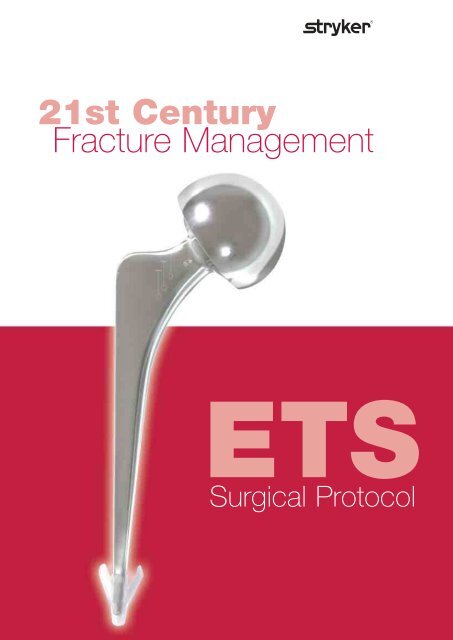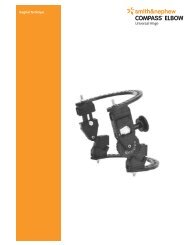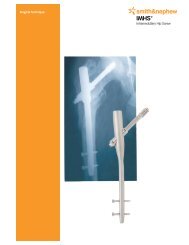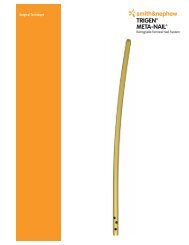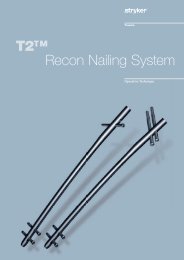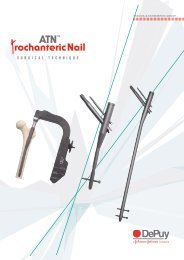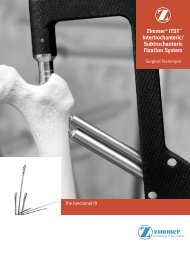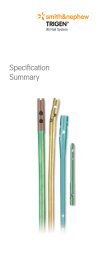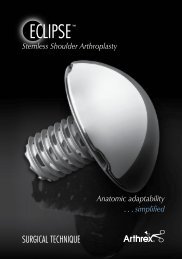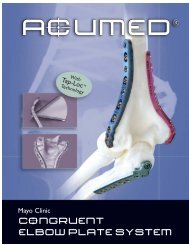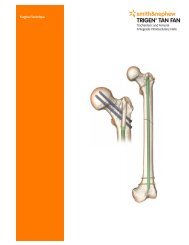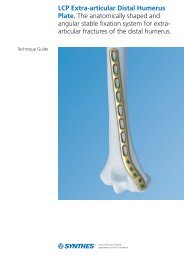Exeter trauma stem hip hemiarthroplasty
Exeter trauma stem hip hemiarthroplasty
Exeter trauma stem hip hemiarthroplasty
Create successful ePaper yourself
Turn your PDF publications into a flip-book with our unique Google optimized e-Paper software.
21st Century<br />
Fracture Management<br />
ETS<br />
Surgical Protocol
ETS Operative Technique<br />
Step 1<br />
Confirm that a cemented<br />
<strong>hemiarthroplasty</strong> is indicated.<br />
An X-ray template of the ETS is<br />
provided. This should be used as a<br />
guide with the pre-operative X-ray,<br />
comparing both affected and contra<br />
lateral <strong>hip</strong>s. Particular care should be<br />
made regarding the likely <strong>stem</strong><br />
insertion depth in relation to the tip of<br />
the greater trochanter. (Figure 1).<br />
Pre-op templating is strongly<br />
recommended to assess the correct<br />
level of insertion. The easiest and most<br />
reliable way to do this is to template<br />
against the opposite, unfractured <strong>hip</strong><br />
on the AP pelvis X-ray. After placing<br />
the template over the upper femur,<br />
note the position of the shoulder of<br />
the prosthesis relative to the tip of the<br />
greater trochanter. On average this is<br />
about 12mm below the tip of the<br />
trochanter, but will be less in valgus<br />
<strong>hip</strong>s, and more in varus.<br />
Step 2<br />
The patient is positioned and prepared on the<br />
operating table in the usual manner. Expose the <strong>hip</strong><br />
joint using your preferred surgical approach<br />
for <strong>hemiarthroplasty</strong>. (Figure 2).<br />
NOTE: The authors recommend an anterolateral<br />
approach 1 in the majority of cases.<br />
Figure 2 Patient position.<br />
Figure 3 Cut neck at desired level. Figure 4 Measure head size.<br />
Step 3<br />
Following exposure of the <strong>hip</strong>, cut the<br />
femoral neck 1 to 1.5cm above the<br />
lesser trochanter. The exact level and<br />
orientation of neck cut is not critical<br />
as the ETS has no collar or other<br />
features which will affect the<br />
osteotomy line. (Figure 3).<br />
Remove and measure the femoral head<br />
or alternatively use an appropriate<br />
instrument to estimate the size of the<br />
acetabulum. (Figure 4).<br />
Figure 1 X-ray with overlying template.<br />
The ETS is a relatively slim <strong>stem</strong> with a 40mm offset, suitable for the majority of<br />
cases. However, a small number of patients may have size or offset that is<br />
significantly different. If pre-op templating suggests that this is the case, any of the<br />
<strong>stem</strong>s in the <strong>Exeter</strong> range (from 30mm to 50mm offset and from 0 to 5 <strong>stem</strong><br />
size) can be combined with a UHR bipolar head to create a modular<br />
<strong>hemiarthroplasty</strong>. The similarities between the ETS and the <strong>Exeter</strong> <strong>stem</strong> make<br />
this a straight forward process for even the less experienced surgeon and theatre<br />
team. This is not an option with other commonly used hemiarthroplasties, such<br />
as the Thompsons or Austin-Moore.
Step 4<br />
Ensuring that the gluteus medius<br />
tendon is retracted and protected,<br />
a box chisel is used to open the<br />
proximal femur. This should be<br />
positioned laterally and posteriorly<br />
to gain exposure in line with the<br />
femoral canal. (Figure 5).<br />
Step 5<br />
The taper pin reamer is used to open<br />
up the femoral canal. Ensure that it<br />
is directed in a neutral position down<br />
the axis of the femur. Aim at the centre<br />
of the patella if an anterior approach<br />
is being used or, alternatively the<br />
popliteal fossa if a posterior approach<br />
is used. (Figure 6).<br />
Figure 6 Taper pin reamer used<br />
to open femoral canal.<br />
Step 7<br />
Using the rasp as a guide, mark the<br />
cut surface of the femoral neck at<br />
the desired <strong>stem</strong> insertion depth,<br />
using methylene blue or with<br />
diathermy forceps. Likewise the<br />
shoulder of the rasp can also be used<br />
as a reference. (Figure 8).<br />
Figure 8<br />
Mark femoral neck.<br />
Step 6<br />
Figure 5 Box chisel positioned laterally<br />
and posteriorly.<br />
Proximal femur preparation is made with a modular rasp.<br />
The rasp should be inserted with the required amount of anteversion; typically<br />
this is between 0° and 20° depending on the preferred approach.<br />
After rasping the femur, the <strong>Exeter</strong> V40 rasp handle is removed, leaving the<br />
rasp in the femur.<br />
Option : if the rasp is unstable in the cavity, the trial locating pin may be used<br />
to help keep the rasp at the appropriate depth position<br />
Select the appropriate trial head diameter and place the adaptor in it (figure 1a).<br />
Screw it together manually or with the ETS <strong>stem</strong> pusher (figure 1b-3b).<br />
Place the trial head plus adaptor onto the rasp neck (figure 2a) and reduce the<br />
<strong>hip</strong> to allow assessment of leg length and stability.<br />
When dislocating the <strong>hip</strong>, avoid applying undue rotational force to the femur. It is<br />
recommended to use a bone hook placed around the rasp neck to aid dislocation. If<br />
necessary, the trunnion of the rasp can be removed from the trial head adaptor<br />
(figure 3a) and the <strong>hip</strong> dislocated leaving the trial head in the acetabulum. The trial<br />
head is then removed separately. The <strong>stem</strong> pusher may be used to help this removal<br />
(figure 1b).<br />
Figure 1a Figure 2a Figure 3a<br />
To remove the adaptor from the trial head after the trial reduction:<br />
- place the trial head and adaptor assembly onto the <strong>stem</strong> pusher (figure 1b).<br />
- hold the <strong>stem</strong> pusher with one hand and unscrew the head with the other hand<br />
(figure 2b).<br />
Figure 1b Figure 2b Figure 3b
Figure 9 Stem with<br />
centraliser on.<br />
Step 8<br />
Proceed with the preferred method<br />
of cementing technique.<br />
(Modern cementing techniques are<br />
recommended, including the use of<br />
a distal cement plug, thorough lavage<br />
and drying of the canal and retrograde<br />
filling with a cement gun).<br />
Stem Pusher.<br />
Step 9<br />
Revision<br />
In the event of revision of the<br />
<strong>hemiarthroplasty</strong> to a total <strong>hip</strong><br />
replacement, the ETS can be tapped<br />
back out of the cement mantle after<br />
clearing any cement or fibrous tissue<br />
from over the shoulder of the<br />
prosthesis.<br />
Prior to insertion of the <strong>stem</strong>, the<br />
cement centraliser should be placed<br />
on the distal <strong>stem</strong> tip. (Figure 9).<br />
Both a winged and wingless cement<br />
centraliser are included with the<br />
prosthesis. For a canal size of 10mm<br />
or less, the wingless centraliser should<br />
be used.<br />
The ETS is a slim component and is collarless. As a result there is greater freedom<br />
of position when it is being inserted. As the <strong>stem</strong> is collarless, <strong>stem</strong> position is not<br />
influenced by the neck cut, and it is a simple matter to adjust for leg length by<br />
either increasing or decreasing the distance of <strong>stem</strong> insertion. However, for just<br />
the same reasons, it is also possible if care is not taken to unduly lengthen or<br />
shorten the leg by over or under insertion of the <strong>stem</strong>.<br />
Unlike a Thompsons or Austin-Moore, which is simply inserted until the collar<br />
hits the neck cut, with the ETS the surgeon needs to make a positive decision as to<br />
the correct distance of <strong>stem</strong> insertion.<br />
The <strong>stem</strong> is inserted to the previously determined level in Step 7, using the <strong>stem</strong><br />
insertion instrument. Place a thumb over the cement in the calcar, to maintain<br />
pressure during <strong>stem</strong> insertion.<br />
The <strong>stem</strong> should be inserted with the chosen degree of anteversion as previously<br />
determined in Step 6.<br />
As the ETS is slim distally, it is free to rotate in the proximal femur, and the<br />
surgeon must hold the <strong>stem</strong> in the required degree of anterversion until the<br />
cement sets. If the surgeon fails to do so, soft tissue impingement against the<br />
prosthetic head may push it into excessive anteversion, or the weight of the head<br />
can cause it to rotate into retroversion.<br />
Step 10<br />
Reduce the <strong>hip</strong>, and after confirming<br />
stability and a concentric reduction,<br />
close the wound in a routine fashion.<br />
After acetabular preparation a size 0<br />
(44mm or 37.5mm offset) <strong>Exeter</strong><br />
<strong>stem</strong> can easily be recemented into<br />
the original cement mantle.
Modular Rasp Instrumentation<br />
Catalogue No. Designation<br />
1150-2338<br />
to Unipolar/bipolar trials.<br />
1150-2356 Diameter 38mm to diameter 56mm.<br />
0590-3-211 ETS Trial rasp adaptor<br />
0590-3-210 ETS Trial rasp<br />
0570-9-000 Trial location pin<br />
0930-9-005 <strong>Exeter</strong> V40 rasp handle<br />
0590-3-230 Stem pusher
ETS Instruments & Implants<br />
Implants<br />
Cat No. Head Diameter<br />
mm<br />
0590 3 038 38<br />
0590 3 040 40<br />
0590 3 041 41<br />
0590 3 042 42<br />
0590 3 043 43<br />
0590 3 044 44<br />
0590 3 045 45<br />
0590 3 046 46<br />
0590 3 047 47<br />
0590 3 048 48<br />
0590 3 049 49<br />
0590 3 050 50<br />
0590 3 052 52<br />
0590 3 054 54<br />
0590 3 056 56<br />
Instruments<br />
Cat No. Description<br />
0590 3 240 Femoral Head<br />
Extractor<br />
0590 3 250 Skid<br />
0932 0 000 <strong>Exeter</strong> Taper<br />
Pin Reamer small<br />
0590 3 260 Instrument Tray<br />
4842 3 012 Box Chisel 12mm<br />
Head Gauges<br />
0590 3 270 Small<br />
(38, 40, 41, 42, 43mm)<br />
0590 3 280 Medium<br />
(44, 45, 46, 47, 48mm)<br />
0590 3 290 Large<br />
(49, 50, 52, 54, 56mm)<br />
0937 3 200 Stem Seal<br />
Backing Plate<br />
ETSTP01E01 X-ray Template
Notes
Acknowledgments:<br />
Published in collaboration with the following contributing surgeons:<br />
G A Gie FRCS, A J Timperley FRCS, M J W Hubble FRCS. Princess Elizabeth Orthopedic Centre, <strong>Exeter</strong><br />
References:<br />
1. Hardinge K. The direct lateral approach to the <strong>hip</strong>. J Bone Joint Surg, 1982, 64B:17-19<br />
The information presented in this brochure is intended to demonstrate a Stryker product. Always refer to the<br />
package insert, product label and/or user instructions before using any Stryker product. Products may not be<br />
available in all markets. Product availability is subject to the regulatory or medical practices that govern<br />
individual markets. Please contact your Stryker representative if you have questions about the availability<br />
of Stryker products in your area.<br />
Products referenced with a designation are trademarks of Stryker<br />
Products referenced with a ® designation are registered trademarks of Stryker<br />
Literature Number: ETSOT05E02<br />
MTX/GS 05/07<br />
Copyright ©2007 Stryker<br />
Printed in US<br />
Stryker SA<br />
Cité Centre<br />
Grand-rue 90<br />
1820 Montreux<br />
Switzerland<br />
t: +41 21 966 12 01<br />
f: +41 21 966 12 00<br />
www.europe.stryker.com


